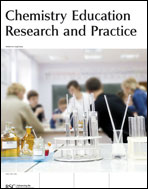Exploring conceptual frameworks of models of atomic structures and periodic variations, chemical bonding, and molecular shape and polarity: a comparison of undergraduate general chemistry students with high and low levels of content knowledge
Abstract
The purpose of the study was to explore students’ conceptual frameworks of models of atomic structure and periodic variations, chemical bonding, and molecular shape and polarity, and how these conceptual frameworks influence their quality of explanations and ability to shift among chemical representations. This study employed a purposeful sampling technique and used three diagnostic instruments for conceptual understanding to determine the students’ level of content knowledge of the related concepts. Six student interviews were analyzed to portray students’ conceptual frameworks in high and low content knowledge (HCK and LCK, respectively) groups. The study’s major findings revealed that moving from a high toward a low level of content knowledge, the quality of students’ explanations declined, as did their ability to reconcile new information to their existing knowledge frameworks. Three essential concepts – models of atomic structure, effective core charge and principles of electrostatic force, and quantum mechanics descriptions – were identified that may explain students’ failure to learn the necessary aspects of molecular geometry and polarity. This study provides empirical evidence of how students’ content knowledge influences their understanding about molecular polarity. The findings have implications for college chemistry education with respect to teaching concepts about molecular polarity.

 Please wait while we load your content...
Please wait while we load your content...